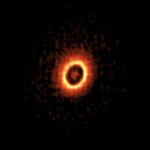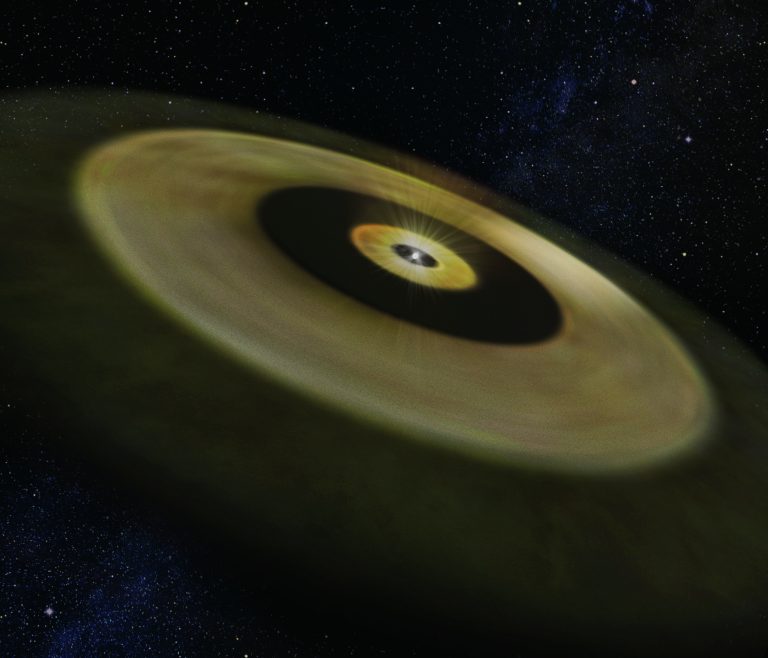
ALMA image of the dusty disk around the young star DM Tau. You can see 2 concentric rings, where planets may be forming. Image via ALMA.
Japanese astronomers reported this month on their observations of the formation sites of planets around a young star resembling our sun. The star is DM Tau, located 470 light-years away in the direction of our constellation Taurus the Bull. The astronomers observed it using the ALMA telescope in the Atacama Desert of northern Chile. DM Tau is about half the mass of our sun. It’s estimated to be 3 to 5 million years old, in contrast to our sun’s 4.6 billion years. The astronomers spied two rings of dust around the star, at distances comparable to our sun’s asteroid belt and the orbit of the planet Neptune. The rings at these distances suggest we’re seeing the formation of a planetary system similar to our own.
The peer-reviewed Astrophysical Journal published these results in November 2018. The astronomers presented them this month at the annual meeting of the Astronomical Society of Japan.
Tomoyuki Kudo of the National Astronomical Observatory of Japan (NAOJ) led the research. He said:
Previous observations inferred two different models for the disk around DM Tau. Some studies suggested the radius of the ring is about where the solar system’s asteroid belt would be. Other observations put the size out where Neptune would be. Our ALMA observations provided a clear answer: both are right. DM Tau has two rings, one at each location.
The researchers said they also found a bright patch in the outer ring. This indicates a local concentration of dust, which would be a possible formation site for a planet like Uranus or Neptune. Jun Hashimoto, a researcher at the Astrobiology Center, Japan, commented:
We are also interested in seeing the details in the inner region of the disk, because the Earth formed in such an area around the young sun. The distribution of dust in the inner ring around DM Tau will provide crucial information to understand the origin of planets like Earth.

Artist’s concept of the disk around the young star DM Tau. Planets such as our Earth – and the other planets in our solar system – are thought to have formed in a dusty disk like this one. Image via NAOJ.
Botton line: Astronomers have spied 2 rings of dust – the possible birthplace of planets, similar to those in our solar system – around the young sunlike star DM Tau.
Source: A Spatially Resolved au-scale Inner Disk around DM Tau
from EarthSky https://ift.tt/2FCL2Lh

ALMA image of the dusty disk around the young star DM Tau. You can see 2 concentric rings, where planets may be forming. Image via ALMA.
Japanese astronomers reported this month on their observations of the formation sites of planets around a young star resembling our sun. The star is DM Tau, located 470 light-years away in the direction of our constellation Taurus the Bull. The astronomers observed it using the ALMA telescope in the Atacama Desert of northern Chile. DM Tau is about half the mass of our sun. It’s estimated to be 3 to 5 million years old, in contrast to our sun’s 4.6 billion years. The astronomers spied two rings of dust around the star, at distances comparable to our sun’s asteroid belt and the orbit of the planet Neptune. The rings at these distances suggest we’re seeing the formation of a planetary system similar to our own.
The peer-reviewed Astrophysical Journal published these results in November 2018. The astronomers presented them this month at the annual meeting of the Astronomical Society of Japan.
Tomoyuki Kudo of the National Astronomical Observatory of Japan (NAOJ) led the research. He said:
Previous observations inferred two different models for the disk around DM Tau. Some studies suggested the radius of the ring is about where the solar system’s asteroid belt would be. Other observations put the size out where Neptune would be. Our ALMA observations provided a clear answer: both are right. DM Tau has two rings, one at each location.
The researchers said they also found a bright patch in the outer ring. This indicates a local concentration of dust, which would be a possible formation site for a planet like Uranus or Neptune. Jun Hashimoto, a researcher at the Astrobiology Center, Japan, commented:
We are also interested in seeing the details in the inner region of the disk, because the Earth formed in such an area around the young sun. The distribution of dust in the inner ring around DM Tau will provide crucial information to understand the origin of planets like Earth.

Artist’s concept of the disk around the young star DM Tau. Planets such as our Earth – and the other planets in our solar system – are thought to have formed in a dusty disk like this one. Image via NAOJ.
Botton line: Astronomers have spied 2 rings of dust – the possible birthplace of planets, similar to those in our solar system – around the young sunlike star DM Tau.
Source: A Spatially Resolved au-scale Inner Disk around DM Tau
from EarthSky https://ift.tt/2FCL2Lh

Aucun commentaire:
Enregistrer un commentaire